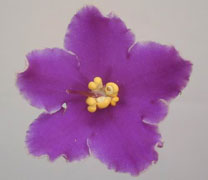


Home
Flowers &
Indoor Plants
Fruits & Nuts
Ornamentals
Vegetables
Special Topics
Resources
Glossary

|
African Violet Saintpaulia sp. (saint-pawl-ee-ah)  Click on thumbnails for larger image. |
 |
| What about it?
The Baron Walter von Saint Paul discovered the African violet in the Usambara mountains of East Africa in 1892. This explains the origins of the genus name Saintpaulia. After bringing the plant to Europe, it spread to England and eventually to the United States. It is now one of the most popular houseplants in use. In fact, in 1946 the African Violet Society of America was founded in the plant's honor. What is it used for? African violets come in a great variety of shades of purple, violet, pink, and white, as well as miniature and cascading forms. They can bloom continuously and make a splendid addition to any room. Further, the African violet will stay small and perfectly "pot-sized" for a window-sill or bookshelf. Where does it grow: How do we grow it? African violets do best in temperatures between 65-70 degrees F. They can survive either colder or warmer temperatures but they will not bloom under less-than-ideal-conditions. High temperatures will wilt or harden the leaves; low temperatures will make the leaves curl and slow plant growth. African violets love humidity- spray the leaves with warm water occasionally. (Cool water causes spotting on the leaves.) They also need plenty of sunlight, although direct summer sunlight may damage the leaves. What are its primary problems? The number one cause of African violet death is overwatering. Don't kill your plants with kindness! Water only when the topsoil is dry to the touch. Due to overwatering, African violets usually suffer from some type of rotting: Crown rot, root rot, petiole rot, etc. Powdery mildew might come before any of these "rots" -so be on the lookout. They are also susceptible to cyclamen mites, nematodes, aphids, mealybugs and thrips. How do we propagate it? African violets can easily be grown from a cutting. Just cut the leaf near its base and set the bottom two inches of the leaf stem in water until new roots begin to form. Then, place the plant in fresh soil. African violets can also be started from seed.
© Copyright, Department of Horticulture, Cornell University. |